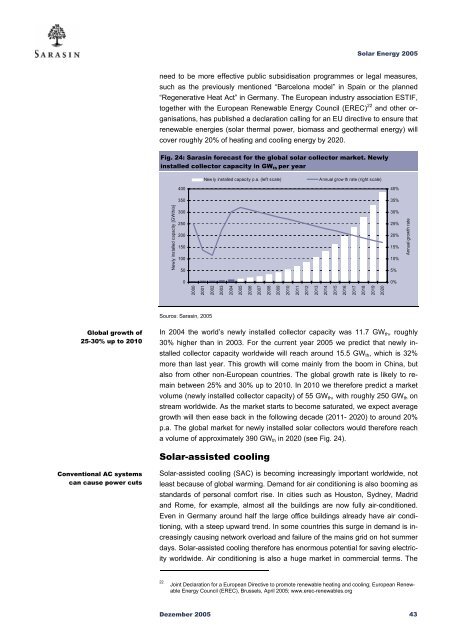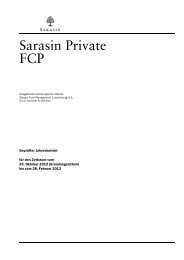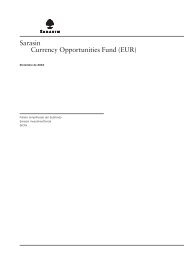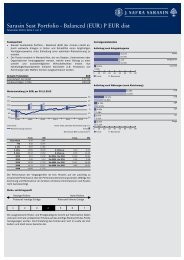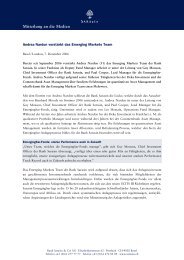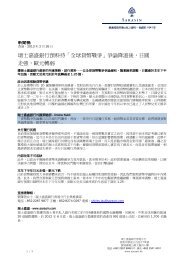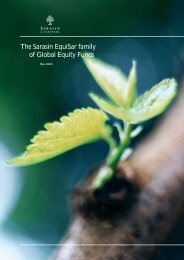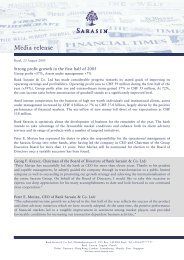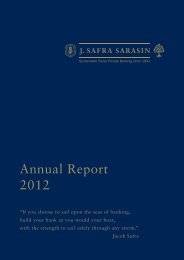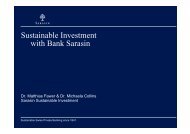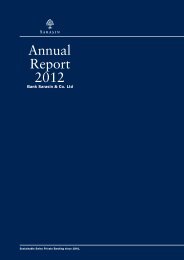Sustainability Report - Bank Sarasin-Alpen
Sustainability Report - Bank Sarasin-Alpen
Sustainability Report - Bank Sarasin-Alpen
Create successful ePaper yourself
Turn your PDF publications into a flip-book with our unique Google optimized e-Paper software.
Solar Energy 2005<br />
need to be more effective public subsidisation programmes or legal measures,<br />
such as the previously mentioned “Barcelona model” in Spain or the planned<br />
“Regenerative Heat Act” in Germany. The European industry association ESTIF,<br />
together with the European Renewable Energy Council (EREC) 22 and other organisations,<br />
has published a declaration calling for an EU directive to ensure that<br />
renewable energies (solar thermal power, biomass and geothermal energy) will<br />
cover roughly 20% of heating and cooling energy by 2020.<br />
Fig. 24: <strong>Sarasin</strong> forecast for the global solar collector market. Newly<br />
installed collector capacity in GW th per year<br />
New ly installed capacity p.a. (left scale)<br />
Annual grow th rate (right scale)<br />
400<br />
40%<br />
350<br />
35%<br />
Newly installed capacity [GWth/a]<br />
300<br />
250<br />
200<br />
150<br />
100<br />
50<br />
30%<br />
25%<br />
20%<br />
15%<br />
10%<br />
5%<br />
0<br />
2000<br />
2001<br />
2002<br />
2003<br />
2004<br />
2005<br />
2006<br />
2007<br />
2008<br />
2009<br />
2010<br />
2011<br />
2012<br />
2013<br />
2014<br />
2015<br />
2016<br />
2017<br />
2018<br />
2019<br />
2020<br />
Annual growth rate<br />
0%<br />
Source: <strong>Sarasin</strong>, 2005<br />
Global growth of<br />
25-30% up to 2010<br />
In 2004 the world’s newly installed collector capacity was 11.7 GW th , roughly<br />
30% higher than in 2003. For the current year 2005 we predict that newly installed<br />
collector capacity worldwide will reach around 15.5 GW th , which is 32%<br />
more than last year. This growth will come mainly from the boom in China, but<br />
also from other non-European countries. The global growth rate is likely to remain<br />
between 25% and 30% up to 2010. In 2010 we therefore predict a market<br />
volume (newly installed collector capacity) of 55 GW th , with roughly 250 GW th on<br />
stream worldwide. As the market starts to become saturated, we expect average<br />
growth will then ease back in the following decade (2011- 2020) to around 20%<br />
p.a. The global market for newly installed solar collectors would therefore reach<br />
a volume of approximately 390 GW th in 2020 (see Fig. 24).<br />
Solar-assisted cooling<br />
Conventional AC systems<br />
can cause power cuts<br />
Solar-assisted cooling (SAC) is becoming increasingly important worldwide, not<br />
least because of global warming. Demand for air conditioning is also booming as<br />
standards of personal comfort rise. In cities such as Houston, Sydney, Madrid<br />
and Rome, for example, almost all the buildings are now fully air-conditioned.<br />
Even in Germany around half the large office buildings already have air conditioning,<br />
with a steep upward trend. In some countries this surge in demand is increasingly<br />
causing network overload and failure of the mains grid on hot summer<br />
days. Solar-assisted cooling therefore has enormous potential for saving electricity<br />
worldwide. Air conditioning is also a huge market in commercial terms. The<br />
22<br />
Joint Declaration for a European Directive to promote renewable heating and cooling; European Renewable<br />
Energy Council (EREC), Brussels, April 2005; www.erec-renewables.org<br />
Dezember 2005 43


